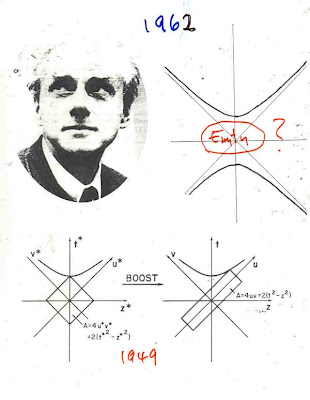Richard Feynman developed the path integral formulation of quantum mechanics in 1948 (some preliminaries were worked out earlier, in the course of his doctoral thesis work with John Archibald Wheeler) as a description of quantum theory corresponding to the action principle of classical mechanics. It replaces the classical notion of a single, unique history for a system with a sum, or functional integral, over an infinity of possible histories to compute a quantum amplitude.
I do not know if I have fallen astray from the interesting perspective strings has alloted to us, in the way in which we have always percieve the quantum mechanical discription based on some," sum over history" of all interactions.
Under the heading of "Time and the Quantum," Pg 189 Fabric of the Cosmo, by Brian Greene a interesting statement of historical proportions that askes questions about the nature of the way in which we percieve same. A better indication of the Full Monty, is demonstrated as well?:)
The beam splitter is not a labratory variety, either, but is a intervening galaxy whose gravitatinal pull can act like a lens that focuses passing photons and directs them to earth,as in Figure 7.3. Although no one has yet carried out this experiment, in principle, if enough photons from the quasar are collected, they should fill out an interference pattern on a long-exposure photographic plate, just as in the labratory beam-splitter experiment. But if we put another photon detector near te end of one route or the other, it which provide which path information for the phtons, thereby destroying the interference pattern.
I have shown, where this extra dimension was added by Kaluza in 1919, and unless I am quoting the references to Kaku wrong, then such considerations would to me, have changed the way in which we would percieve all these interactions? Something then has happened to the spacetime fabric and how all these interactions would be conceptually addressed? Hence the reference to what String Theorists have done, by changing the disciption to one of strings?
Similarily, the laws of gravity and light seem totally dissimilar. They obey different physical assumptions and different mathematics. Attempts to splice these two forces have always failed. However, if we add one more dimension, a fifth dimension, to the previous four dimensions of space and time, then equations governing light and gravity appear to merge together like two pieces of a jigsaw puzzle. Light, in fact, can be explained inthe fifth dimension. In this way, we see the laws of light and gravity become simpler in five dimensions.
Immediately to me, the instantaneous feature of photon expression would have detailed a topological value, where such gravitation/photon would demonstrated of itself a continuity of expression? If such geometrical tendencies would have considered the dynamical relationship of the orbital on cosmological correlations then such energy perceptions would have immediately painted a portrait for us, of what has existed in the past, what continues to exist, and what will exist in the future?

